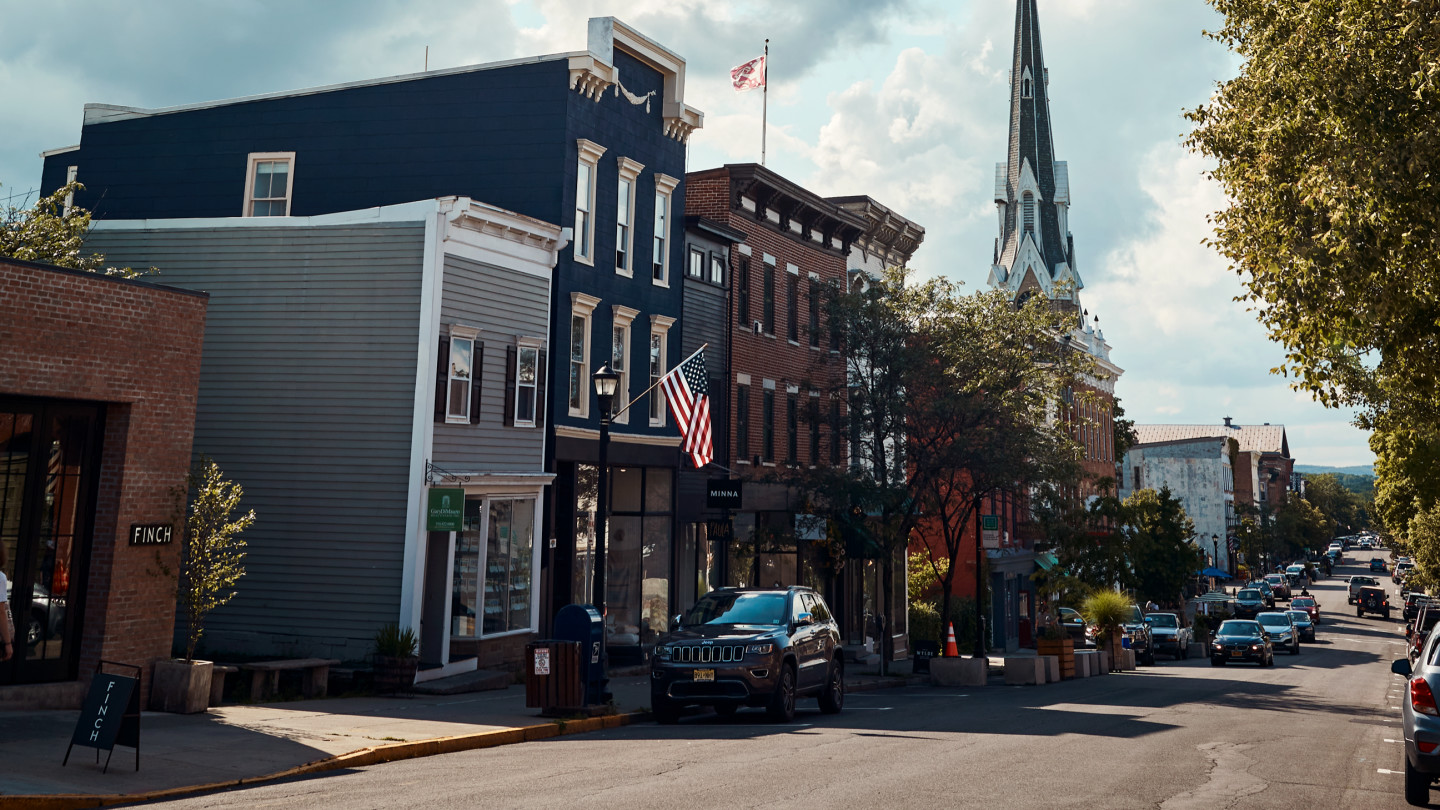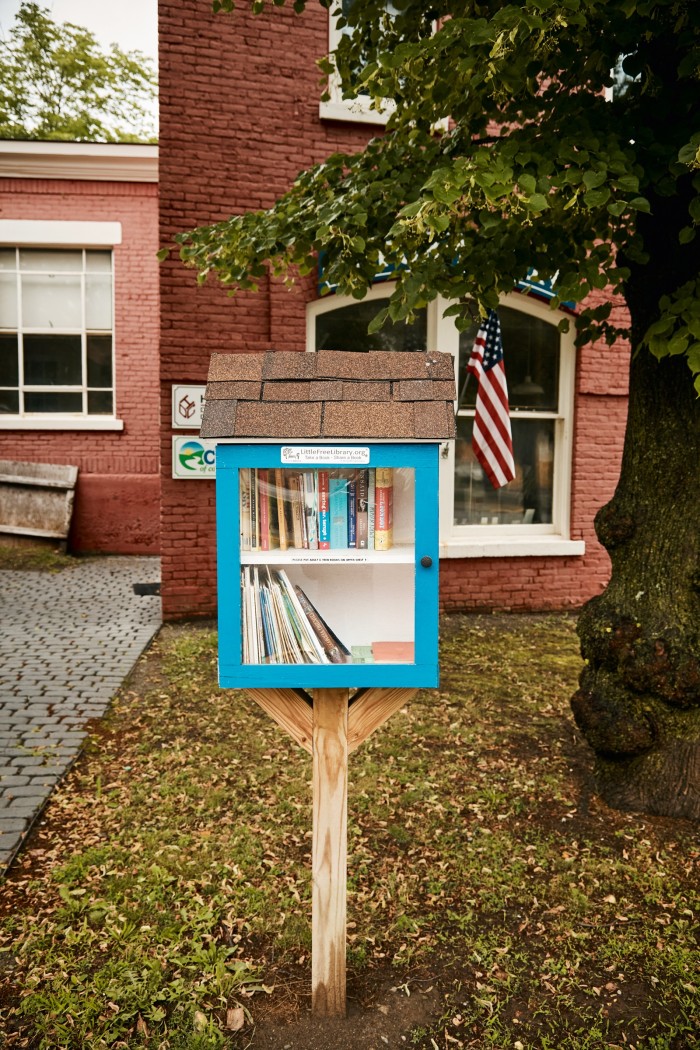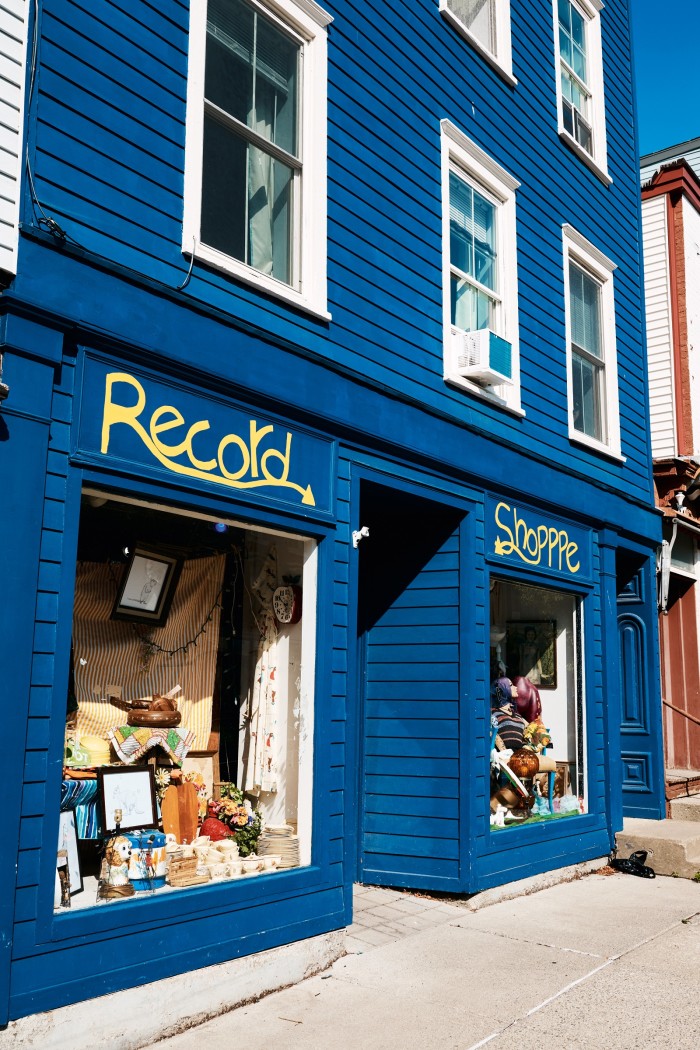Why is everyone decamping to Hudson?

Roula Khalaf, Editor of the FT, selects her favourite stories in this weekly newsletter.
As a weekend getaway for New Yorkers, the Hudson Valley has always been the anti-Hamptons – less fancy, fewer high-gloss celebrities, and with an assurance that you’re not going to run into all the people you claim to be leaving the city to get away from. Straddling the Hudson River as it flows south from Albany to just above New York City, its 7,000 square miles are wrapped by mountains and cliffs, and even a fjord that cuts through the lower end, where I live.
When my husband and I moved to New York City 25 years ago, we bought a small house in Garrison, on the east of the river, so I could garden. I would often toil 40 hours over a weekend, working into the night by the headlights of the car. Then came years when family and work intervened, and upstate life took a back seat. When the children went off a few years ago, I swapped out life as a magazine editor for willow-basket weaving and tea-making. But NYC remained my primary home – until the pandemic. Grounded, but fortunate enough to have an alternative to months sitting it out in a Manhattan apartment, I had the chance to take in every miraculously tiny change of season, from bud to leaf and flower, and from seed to winter slumber. As lively as the rebounding city is now, it won’t be getting me back any time soon.
I am not alone in this. In fact, I’m a demographic cliché. Throughout quarantine, city dwellers with houses to go to mostly fled, along with others who bought, rented and freeloaded up and down the Hudson. As a result, the region is experiencing one of its periodic revivals – a migration of urbanites in search of a more pastoral way of life, one embedded in community and the landscape.



The artist Dustin Yellin, founder of the artist-run cultural centre Pioneer Works in Red Hook, Brooklyn, decamped upstate to stay with friends, and ended up buying a house on a lake near Cold Spring – a move he had been thinking about making for 15 years. But “if it hadn’t been for Covid-19, I’m not sure I ever would have slowed down enough to do it”, he admits. Yellin, a near-manic workaholic in the city, spent the pandemic months moving stones and moss, slowly cultivating a Kyoto-inspired rock garden. His appreciation for the Hudson Valley has only deepened. “Forget that there are so many cool people here; there’s so much else here. I’ve become obsessed with the history of the region and the [Revolutionary] war, and I love the river, and driving along it,” he says, ticking off some of his favourite places: Mohonk Mountain House, the DIA Beacon arts centre, Storm King sculpture park, antique shops in Hudson where he goes to look for “weird objects” for his house.
The writer Malcolm Gladwell, who had been spending weekends in the Hudson Valley, also bought and renovated a house in the city of Hudson proper. It’s now the upstate outpost for NYC-based Pushkin Industries, the podcasting company Gladwell founded with Jacob Weisberg (full disclosure: the latter is my husband). Several Pushkin staffers already lived in the area, and the building operates like an ad-hoc co-working space for friends such as screenwriter Charles Randolph and New Yorker writer Michael Specter. “When I bought my house, it never occurred to me that I would leave the city completely,” says Specter. “But the more time I spent here, the less I wanted to spend there. It turns out that I love gardening. It’s a great place for a serious cyclist. My dog doesn’t have to pretend that the ground isn’t made of concrete. There are plenty of creative people and yet no book parties. Heaven.”


The phenomenon is most pronounced around Hudson itself, which, according to real estate agent Nicole Vidor, who has lived and worked in the area for 20 years, “is on fire”. For years a refuge for artists, writers, and the kind of creative New Yorkers who dwell downtown, Hudson and its near mid-Hudson Valley neighbours – Kinderhook, Germantown, Tivoli, Red Hook and Kingston – have seen property prices skyrocket since the pandemic began. “We have never been so flooded by people wanting to move here, or seen available stock dip so low,” says Vidor.
Hudson charms with its neat grid of streets lined with well-preserved 18th- and 19th-century buildings. Dutch colonists lived here in the 17th century, negotiating ownership of land from the native Mahican people, its original inhabitants. After the English gained control in the 18th century, Hudson was settled by whalers and became an active port town for more than a century. The collective American romantic notions of the area come directly from the 19th-century Hudson River School landscape paintings by artists such as Thomas Cole, and from writers such as Washington Irving. And while many of the vistas they heralded still exist, the land has been under threat for as long as it’s been memorialised.


When the Erie Canal was built in the 1820s, the Valley became a major industrial corridor, with factory buildings dominating Hudson and immigrants arriving to work in them. In the 20th century, as these were abandoned, the towns fell into steep decline, leaving them vulnerable to cheap development and landscape-scarring, air-polluting industry. Some of this was fended off by early environmental activism. Soon after, in the ’80s and ’90s, a first wave of creative pioneers – among them David Bowie and Iman, Brice and Helen Marden, Ellsworth Kelly and Gregory Crewdson – arrived, attracted by the affordable real estate, great architecture, big studio spaces and sublime setting. On their heels came others, and Hudson became a day-trip and weekend destination for New Yorkers looking for antiques and handmade or independent design. Many of its derelict factories and warehouses were transformed into cultural, music and community gathering places.



Part of what makes this moment different, however, is people realising they can work remotely,” says Vidor. “So they’re able to make big life changes.” Mona Talbott (a veteran of Berkeley’s Chez Panisse and the food programme at the American Academy in Rome) and Kate Arding (a cheesemonger who worked at Neal’s Yard) were among the first of the new wave. They moved to Hudson from Brooklyn and Hillsdale several years ago to open their tiny cult cheese and provisions shop, Talbott & Arding. “I wanted to be closer to the farms, and the best local farms and orchards are in the Hudson Valley,” Talbott says. She relishes feeding writers and farmers alike, and particularly loves it when the farmers drop off their produce in the back and then drive round the front to shop. But it was the pandemic that made their dream of a large destination space where locals and others can gather into a practical reality. “So many people have moved up here or made their second homes into their primary ones. Occasional customers have become regulars, and so the timing was perfect,” she says. The couple have taken over an 8,000sq ft former children’s clothing factory from the 1940s with a big production kitchen, a retail space and room for seating, so people can stop in for lunch or a coffee before picking up fresh pasta or bread or dessert and heading home.
Others who moved before the pandemic have felt their conviction that they’re in the right place solidify. The British fashion designer Katie Hillier came a few years ago after falling in love with a Hudsonite, the furniture-maker and sculptor Jeff West, back when her life involved jetting around the world for her London-based label Hillier Bartley. “The change from compact city to sprawling countryside with mountains has been amazing for my creativity and productivity,” she says. “I can think and turn ideas into reality with much more ease.” Recently the couple moved from the centre of Hudson to a house at the base of the mountain where Olana, Frederic Church’s famous gothic mansion, sits; Hillier now shares its majestic 19th-century Hudson River School view of the Catskills. They try to live as lightly as possible on the land: they renovated with local materials, are growing vegetables for the first time, and have plans to put in solar panels. Still, Hillier finds herself heading to Warren Street, the town’s main drag, every day. “I crave the village community, which is so important here. There’s a really solid support network between local businesses and I’m surrounded by artisans and makers, creatives and artists, which I love and am inspired by.” On weekends, designers Olympia Le-Tan and Jonathan Saunders might come up from the city to visit Hillier’s favourite swimming hole, located down a pathway behind the car park of Gracie’s Luncheonette (“the best doughnuts,” Hillier confirms). “I am as connected to what’s happening in the world here as I was when I was in the city,” she says. “Perhaps that’s because of social media. But here I also actively participate in what’s happening.”
Katie Hillier

The fashion designer finds inspiration for herself, her work and her home in Hudson proper. On her radar: Nina Z for vintage clothing and Henry art gallery on Warren Street for antique textiles; Flowerkraut for plants; Les Indiennes for block-print fabrics; Naga for Japanese screens; and Alder & Co in Germantown for clothing and homewares.
Others, like chef Clare de Boer, were weekenders who set down deeper roots during the pandemic. A co-owner of King, one of Manhattan’s hottest restaurants, de Boer, her husband Luke Sherwin and their baby holed themselves up in the house they bought in nearby Dover Plains. “Watching the seasons change in this landscape changed my cooking,” she says. “In the beginning, I would bring food up from the city. By the end, I was growing all my own here and bringing it down to the restaurant.” The couple bought a farm so they can grow produce to host community dinners, and have plans to open a restaurant in the area.
Part of what has changed for de Boer is her relationship to the community of full-time residents, many of them of an older generation – hunters, birders, farmers – who have a profound connection to, and knowledge of, the land. “You have limited exposure to a place as a weekender – the community of full-timers is a bit of a secret club,” she explains. “But slowly, with the signs of our commitment to this place and its future, I feel like we have become true and trusted members of it.”
Clare de Boer

The King chef frequents the Fat Apple Farm Store in Pine Plains, Talbott & Arding – “my absolute favourite shop in Hudson” – for cheeses and provisions, Churchtown Dairy’s farm store for “the best raw milk in the area”, and Fortunes in Tivoli for its delicious ice cream.
Michael Lindsay-Hogg

An avid collector of unusual items, the director, memoirist and painter likens Hudson’s antique stores to those in Palm Springs – eclectic but with quality; Regan & Smith and Furlong on Warren Street are favourites. He takes his coffee at Supernatural at 527 Warren Street, roots around in the under-the-radar record shop John Doe, loves the arthouse cinema Time & Space Limited, which also sells books, and extols the hats and clothing of Bosnian-born milliner-designer Behida Dolic.
Others have uprooted their lives entirely to commit to life here. The polymath music, film and theatre director, memoirist and painter Michael Lindsay-Hogg left a life in California for Hudson – one of quite a few who made the cross-country move, according to Vidor. “We started to come to Hudson in 2005 when my stepdaughter was a student at Bard, and liked it a lot; but didn’t think about it a lot,” Lindsay-Hogg says. But at home in Los Angeles, with the wildfires that raged to the north affecting the air quality and crime levels spiking, his mind changed. “I thought, hmm – what if we found a place [there]?”
He and his family drove almost 2,900 miles from LA’s Los Feliz neighbourhood to a Hudson house bought online, sight unseen. He couldn’t be happier about his new life. “In LA, you’re 40 minutes by car to the dentist, 20 minutes to the gym,” he says. In Hudson, he has all he needs and enjoys within walking distance. “And with everything closed last year, for exercise I could just go out and walk the steep hills near our house. Until you’ve been around bad air, you don’t know what a difference clean air makes. In Hudson, a small city, the air is fresh, and in just a few miles, you’re in the country, and it’s even more so.”



Perhaps predictably, the boom is not all idyllic news. Rising values come with rising taxes – a burden for many long-time residents, some of whom are being pushed out. Nearly one-quarter of the city of Hudson’s population lives below the poverty line. “It is crucial that the new residents commit to working alongside the community to create a [tax-based] solution to help local residents stay in their community, and to create a positive alliance between the old and new,” says Vidor. But she sees how many newcomers are socially committed to the spirit of sharing their fortune, resulting in some interesting philanthropic initiatives. Among them are The Spark of Hudson, which offers free courses and pilots a small but significant universal-basic-income programme; and Basilica Hudson, an arts and event centre with largely free programming geared toward supporting creative enterprises in the community. (On a smaller scale, when Samuel’s Sweet Shop – a long-time local favourite of the scene in nearby Rhinebeck – was in danger of going under, one of the investors who stepped in was actor Paul Rudd, another sometime Hudson Valley habitué.)
Vidor’s optimism remains cautious, though. She has recently witnessed a handful of private jets landing in the tiny local airport. It reminds her, she says, of her years living in Aspen, as that Rocky Mountain town was transforming from a local hub into an “international destination”. There’s concern that a similar fate might await the Hudson Valley. But, for now, it’s still in an unexpected sweet spot, with the kind of idiosyncratic originality both in the diversity of its businesses and its communities that many neighbourhoods in New York City have long since lost, or can only aspire to.
Comments